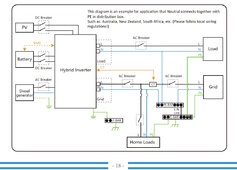Thank you very SeaGal for answer!
I am sorry - not sure that quite understand you. That your message -" inverter can provide then the remaining power ... from the grid".
My concern is that invertor has limited ablity "provide the power". According to the instructions invertor can provide only 8800w. So you're saying about "can provide", but I concern if there is a extra demand - more than "invertor can provide"
Extra power will come from the grid.
My two questions are - If HomeLoad will demand ExtraMaxPower 3200w (12000-8800 = 3200 w ).
a) Invertor will not be damage?
No damage - that is how they are designed to work, as detailed below.
b) If someone has this case in practice?
Yes, I do and so do millions of others with grid-tied inverters

c) (for my own understanding question ). This ExtraMaxPower - will this extra power 3.2kWt flow into HomeLoad without "will or desire" of inverter? That is invertor will not managed this extraCurrent?
Yes. When grid-tied, both the inverter and grid will supply power together, as needed by the house load.
The inverter synchronises its AC grid port output to match the frequency and phase of the incoming grid and will increase its voltage to allow current to flow from the inverter to the house load (and possibly out to export power to the grid, if not specifically restricted).
But, obviously, at some point, either because there isn't much sun or because you reached the limit of the inverter's power output, it can't power enough to keep the house load supplied. At that point, the remaining power will automatically come from the grid, so if the house load is 12000W and the inverter is providing 8800W, then the shortfall of 3200W will be imported from the grid.
Now, you're going to ask how does that work?

This is where ohm's law comes in; V=IR and P=VI. And remembering that the wires from your inverter to the house and from the grid to the house and from the house to the load all have a resistance, albeit (hopefully) very small.
Let me give you a very simplified example, ignoring the effects of inductive loads and grid voltage fluctuation...
- A load 12000W load is switched on and the voltage at that load is 240V.
- A load of 12000W will draw a current of exactly 50A at 240V.
- Let's say the voltage arriving at the house from the grid is 240.7V
- And assume that the resistance of the wire from inverter's grid port to the house load is 0.1 ohms.
- And assume that the resistance of the wire from house grid connection to the house load is 0.05 ohms.
- The inverter can only provide 8800W, which at 240V will be 36.7A.
- So to provide that power of 8800W, the inverter will increase its output voltage by 3.67V (from 36.7A x 0.1 ohms) at its output.
- Hence it is generating a voltage of 243.67V. This will cause 36.7A to flow from the inverter to the house load.
- The remaining current of 13.3A will come from the incoming grid voltage of 240.7V across the 0.05ohm resistance from grid to house load. (0.7V = 0.05 ohms x 13.3A)
In practice, the house loads and grid voltage will fluctuate, so the inverter will typically monitor the incoming voltage once a second and adjust its output voltage to deliver the necessary power. If the house load is less than the inverter's output, then the voltage increase from the inverter will result in current flowing from inverter to grid and you will be exporting power back to the grid (which will be consumed by your neighbours in a similar manner to that described above.)
The use of a current measuring CT clamp in a feedback loop to the inverter is used to either restrict export power if that is needed and to prevent any wasted battery power being exported to the grid when running off batteries.
Please note this is a very simplified explanation, but hopefully enough to get the general idea of how a grid-tied inverter behaves



